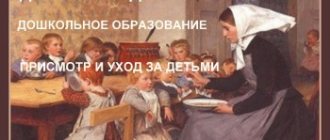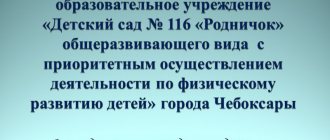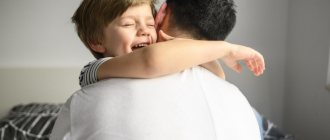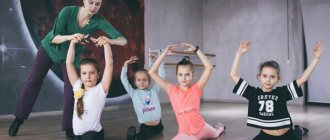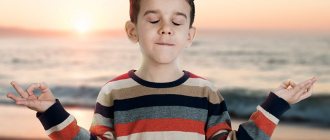Definition 1
An educational program for preschool children is a normative document that represents a plan for constructing the educational process and individualizing the educational route, aimed at achieving standards in the education of preschool children with various educational opportunities.
The educational process in preschool educational institutions is built on the basis of love for children, respect for children's individuality, taking into account the child's readiness to master the necessary knowledge, skills and abilities, as well as the exclusion of violence and coercion in relation to the child's personality.
Programs “Origins”, “Rainbow”, “Childhood”
The “Origins” program is a program developed under the guidance of a team of researchers named after. A.V. Zaporozhets under the guidance of Doctor of Pedagogical Sciences L.A. Paramonova.
Are you an expert in this subject area? We invite you to become the author of the Directory Working Conditions
The main goal of the “Origins” Program is the formation of a full-fledged and comprehensively developed personality of a preschool child, the development of his universal creative abilities in accordance with his age capabilities and needs.
The “Origins” program is designed for children aged from birth to 7 years.
The “Origins” program holistically defines the nature and content of the modern educational process in preschool educational institutions, which is aimed at developing the personal culture of a preschool child.
The main principle of the Origins Program is humane pedagogy, which implies dialogue between:
- child and adult,
- children,
- teacher and parents,
- teachers.
The Rainbow program is a program developed for the preschool educational institution E.V. Solovyov, together with a number of authors and developers (T.N. Dronova, V.V. Gerbova, T.I. Grizik, etc.).
Note 1
The Rainbow program is the first comprehensive program that opens the way to modern variable educational programs for preschool children, which replaced the Standard Educational Program.
Finished works on a similar topic
Course work Educational programs for preschool children 450 ₽ Abstract Educational programs for preschool children 250 ₽ Test work Educational programs for preschool children 240 ₽
Receive completed work or specialist advice on your educational project Find out the cost
The main goal of the Rainbow Program is to preserve and strengthen the health of preschool children, to help every preschooler live their preschool childhood with joy and benefit, as well as to ensure timely and complete mental development for pupils, taking into account their age and individual characteristics.
Currently, the Rainbow Program is the only Program that covers the entire range of problems related to providing the necessary conditions for preserving the health of preschool children, their successful upbringing, training and development.
The Rainbow program is designed for children aged 2 to 7 years.
The “Childhood” program is a program that was developed by a team of teachers from the Department of Preschool Pedagogy of the Russian State Pedagogical University named after. A.I. Herzen.
The main goal of the Childhood Program is to provide the necessary conditions for the full development of the personality of a preschool child.
The “Childhood” program was developed based on the achievements of modern and classical preschool pedagogy. Education of children under this Program is aimed at deepening and systematizing the acquired knowledge, as well as gaining the necessary life experience. The number of classes in the Childhood Program and their duration are not regulated; the teacher must determine this independently, based on the capabilities and needs of the students.
Combined classes
Unlike an integrated lesson, a combined lesson consists of separate parts that are not interconnected and have their own program tasks from one or different divisions of the Program (language teaching and speech development with the environment, physical education, visual arts, fiction).
An important form of teaching elements of literacy to children of senior preschool age are organized classes (group, individual-group, individual).
We advise you to plan once a week group or individual group lessons to teach children the elements of literacy in the senior group, and plan and conduct individual lessons every day with individual children, taking into account their individual characteristics.
We remind you that it is advisable to teach children the elements of literacy and preparation for writing with small groups of children or as group work for children of the sixth and seventh years of life who identify the need to read and write.
Programs “Krokha” and “Kindergarten 2100”
The “Krokha” program is a program designed specifically for the education, training and development of children from birth to 3 years old, under the guidance of authors D.V. Sergeeva, G.G. Grigorievskaya, N.P. Kochetova and a number of others.
The main goal of the “Krokha” Program is to ensure the comprehensive education and development of children from birth to 3 years.
The “Krokha” program is based on humanistic ideas and family values. It involves a multi-level and individually differentiated approach to a young child. The main program of the “Krokha” program is the development of personal qualities in children, based on respect for their needs, interests and desires.
The “Kindergarten 2100” program is a program developed by a team of authors, aimed at solving the continuity of preschool and school education.
The goal of the “Kindergarten 2100” Program is to implement the principle of continuity between kindergarten and school, ensuring the development and education of preschool children.
The “Kindergarten 2100” program is being implemented within the framework of the “School 2100” Educational System concept. Aimed at synchronizing the processes of education, training and development of children at all levels of education. This Program provides for the comprehensive and timely development of preschool children, the formation of their ideas about the world around them and the fundamental foundations of knowledge, skills and abilities necessary for successful learning at school.
Teaching preschoolers the elements of literacy
As the practice of modern preschool educational institutions shows, it is advisable to teach elements of literacy to children of senior preschool age with small groups of children, so group (up to 15 people), individual-group (4-8 people) and individual (1-4 people) will prevail. classes that bring together children of senior preschool age of approximately the same level of development (if children have different levels of development, then separate tasks should be planned for such children).
It’s no secret that among kids there are those who are already interested in sounds and letters or even read words, sentences and the like on their own. We recommend involving such children in group work.
In classes on teaching elements of literacy, which are advisable to be held once a week as a group or individually, children listen to speech, learn that it consists of sentences, sentences are built from words, and words can be divided into syllables and individual sounds.
Characteristics of the main comprehensive programs of our time
Origins. This preschool education program is aimed at ensuring the holistic and comprehensive formation of the intellectual, physical and personal characteristics of children. It establishes the basic features of organizing a child’s activities in a preschool institution, the structure of the education and upbringing process, as well as the prerequisites for turning the program into reality.
Golden Key. Designed for children 3-10 years old, and is aimed at providing the most comfortable learning conditions for children in accordance with their age. Its peculiarity is the creation of conditions that will not only provide learning opportunities, but also preserve joy, emotions and happiness in the learning process for children.
Kindergarten is a house of joy . The first program whose main goal is the unique individuality of each student. Self-awareness and self-development are encouraged.
Paths. This program is designed for children 3-7 years old and aims to develop the child mentally through the use of creativity and imagination.
Teremok. Program for the youngest children - 2 months-3 years. The methods described in the program are innovative, variable, complex.
Steps to the school. The program is applicable to children aged 3-7 years. It comprehensively develops children, preserves and strengthens their health, forms functions that are significant for school, and reduces the risk of improper adaptation to school.
First steps. Designed for children 1-3 years old and aims to develop the child’s activity, emotionality, and independence.
Mosaic. Age group: children 2-7 years old. The program is designed to expand the potential of each child, open up opportunities for positive adaptation and socialization, ensure the development of the child’s personality, and show everyone their creative abilities. The newest ways of organizing educational work are proposed.
PRO children. The program encourages joint activities among preschoolers as they learn about the regulation of their own actions in the process and the actions carried out by their partners. The task of teachers is to develop children’s communication skills, logical thinking, and teach independence and responsibility.
Inspiration. The program sets clear goals and offers the tools teachers need to achieve this. It provides for building a high-quality preschool education process and creating an effective and modern environment for teaching preschoolers.
From birth to school. The new program was developed from the old one, created in 2004. It included new achievements in the practice and science of preschool Russian education.
Kindergarten 2100. The program should provide psychological and pedagogical support for the development of the personality of preschoolers and motivate children to reveal their abilities.
There are also many other complex programs that cannot be discussed within the scope of this work.
Fiction classes
Classes in fiction are held in all age groups: frontal or group lessons at least once a week, individual, individual-group - almost daily.
In the system of educational work of mathematical content, it is necessary to provide for integrated, complex classes.
For example: a combination of mathematics classes with other types of activities - construction, visual arts, physical education, excursions into nature.
Physical education and music classes are planned twice a week.
In autumn, winter and spring, two physical education classes are held in the gym, and three are held outdoors.
| Forms of work | Features of organizing classes | Group | Duration, in minutes |
| Physical education classes | daily | younger | 20-25 |
| average | 25-30 | ||
| older | 30-35 | ||
| preparatory | 35-40 |
An approximate diagram of the calendar planning of the teacher’s educational work for the main routine moments of the first and second half of the day
| The first half of the day | Afternoon | |||
| Morning | Classes | Walk | Labor, independent artistic activity | Entertainment, games |
| Games, conversations, observations, work, individual work with children and parents; independent motor activity of children | Subject. Program content. Material. Plan (course) of the lesson. | Games, work, observations, sports games and exercises, individual work in various sections of the program, excursions, walks. trips outside the kindergarten, independent motor activity of children | Different types of labor (manual, household, outdoor) in different forms. independent artistic activities of children (visual, artistic and design, speech, musical, theatrical) | Various types of theaters (puppet, shadow, toys, etc.), dramatization games, performances, concerts, physical education, musical, literary leisure |
In the second half of the day, you can also schedule the activities of the clubs according to the plans of the leaders of the clubs.
Approximate diagram of calendar planning of educational work of a teacher by types of children's activities and forms of work of a teacher with children
| Play activity | Various types of games: plot-role-playing, construction-constructive, dramatization, didactic and the like. |
| Educational and cognitive activity | Classes (topic, program content, material, course of the lesson) |
| Labor activity | Various types and forms of labor |
| Communication activities | Individual, group, collective conversations with children on personal, moral and ethical topics, organization and acting out of interpersonal communication situations, etc. |
| Cognitive activity | Observations, targeted walks, excursions, children's experimentation, experiments, reading fiction, etc. |
| Motor activity | Outdoor games, elements of sports games and exercises, physical education holidays and entertainment; walks outside the kindergarten, independent motor activity of children |
| Club work | Topics of circle classes according to the plans of the circle leaders |
| Individual work with children and parents | Individual work with children in various sections of the program (games, exercises, conversations, conversations and other forms), individual conversations, conversations, consultations for parents |
